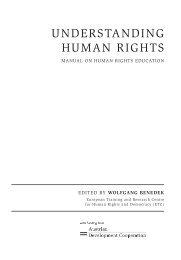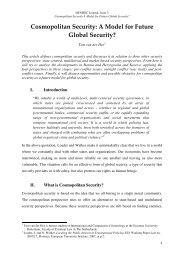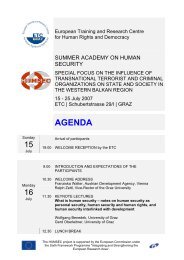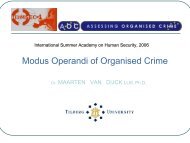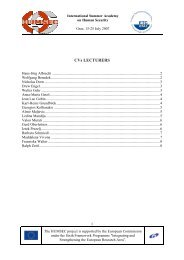Kosovo's Post-independence Inter-clan Conflict - HUMSEC
Kosovo's Post-independence Inter-clan Conflict - HUMSEC
Kosovo's Post-independence Inter-clan Conflict - HUMSEC
You also want an ePaper? Increase the reach of your titles
YUMPU automatically turns print PDFs into web optimized ePapers that Google loves.
<strong>HUMSEC</strong> Journal, Issue 2<br />
Kosovo’s <strong>Post</strong>-<strong>independence</strong> <strong>Inter</strong>-<strong>clan</strong> <strong>Conflict</strong><br />
Despite primordial explanations of ethnic conflict, which blame seething “ancient hatreds”<br />
for inter-group violence, interethnic disputes result from a complex interplay of multiple<br />
causal mechanisms. These include frustrations associated with unequal distribution and unequal<br />
growth rate of wealth, power and status that could be either real or perceived. Ethnic<br />
entrepreneurs determined to fulfill their opportunistic goals of gaining power often manipulate<br />
the perceptions about the ethnic group they oppose. Other explanations for inter-ethnic<br />
violence focus on the role of fear and the associated security dilemmas.<br />
Ethnic violence is oftentimes labeled as irrational. However, Rui de Figueiredo and Barry<br />
Weingast’s game theory model shows that the actions leading to ethnic conflict are “rational,<br />
fear-driven support of violence by average citizens”. 24 According to their model, a<br />
member of group A perceives group B’s actions “as a given,” without differentiating that<br />
not all B members act the same way. Driven by fear and uncertainty vis-à-vis B leaders’<br />
intentions, A members face a security dilemma. A members then behave in ways that produce<br />
violence. This could be different if A’s perception of B is not taken as a given. As in<br />
the case of Milosevic who feared losing power when the former Yugoslavia disintegrated,<br />
attempts by weak leaders to use violence as a tool of manipulation, and as way of stoking<br />
the population’s fear of victimization have powerful causal influence on ethnic conflict. 25<br />
Jeffrey Ross proposes another model for the rise of ethnic violence. Two causal mechanisms<br />
work simultaneously. First, the existence of social, cultural, historical and economic<br />
discontent and the presence of a culture of protest and violence, which are mutually reinforcing,<br />
fuel perceived or real grievances. 26 Second, the failure of a counter-terrorism organization<br />
creates opportunities for the organizational development of terrorism and the<br />
trafficking and stockpiling of weapons and explosives. 27 When traditional channels for resolving<br />
social and political discontent do not address popular grievances, some people find<br />
an outlet for the expression of their grievances through powerful terrorist organizations.<br />
This complex interplay of factors then results in violence against a particular identity group.<br />
The Ross model, when applied to Kosovo, could explain the inter-<strong>clan</strong> violence that is<br />
likely to erupt after <strong>independence</strong>. Prior to the <strong>independence</strong>, the social, cultural, historical<br />
and economic discontent in Kosovo centered around (1) the unresolved status, (2) the still<br />
24<br />
Figueiredo, Rui de and Barry Weingast, The Rationality of Fear: Political Opportunism and Ethnic <strong>Conflict</strong>,<br />
in Walter; Barbara and Jack Snyder (eds.MFKKFBN), Civil Wars, Insecurity, and <strong>Inter</strong>vention, Columbia<br />
University Press, New York, 1999, at p. 292.<br />
25<br />
Figueiredo, Rui de and Barry Weingast, The Rationality of Fear: Political Opportunism and Ethnic <strong>Conflict</strong>,<br />
at pp. 271-275.<br />
26<br />
Ross, Jeffrey, The Rise and Decline of Quebecois Separatist Terrorism in: Studies in <strong>Conflict</strong> and Terrorism<br />
(Volume 18, Issue 4), 1995, at p. 291.<br />
27<br />
Ross, Jeffrey, The Rise and Decline of Quebecois Separatist Terrorism, at p. 288.<br />
118



